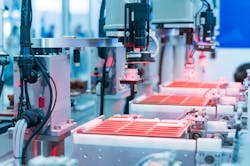One of the discussions that can always spark a debate among controls engineers is which controller is best in certain situations. Each school of thought has its devotees, and they tend to hold passionately to their preferred platforms.
We should look at the basics of what each control system can do to better understand how each system may benefit our needs.
As with many things in our technology-based world, we are finding crossover in systems with similar functions. At one time, the difference between programmable logic controllers (PLCs), programmable automation controllers (PACs) and PC-based control was more clearly defined. However, as technologies are becoming increasingly smarter and often smaller, we are seeing more blurring of the lines of distinction.
Also read: The IPC adapts to advanced control needs
Systems are more useful and more intelligent as we continue to apply our learnings and improve the functionality of the controls.
The goal of any automation is to be able to deliver goods to the consumer and eliminate the human element from the system. By using machines to deliver these goods, we can produce more and do it in a more efficient manner. Machines are more accurate, have a higher tolerance level and produce better quality when a repeatable process is needed for high production levels. It is our job then to figure out how to control all the operations that are needed in any given application by selecting the correct control.
PLCs, PACs and PC-based controls are used to control the daily operations of some automated system. Each of the three increases in complexity and usefulness as the application demands.
Also read: PLC, PAC or PC? How to know why to choose what
The main goal of a PLC, which came of age in the previous century, was to replace older, less reliable relay-based circuits and make the changing of operations simpler. Simply put, a PLC is a highly reliable industrial computer that can be run 24/7 in a production environment.
You can think of a PLC as hardware that will control a process, housed in an electric cabinet for protection from the environment they control and tied to a series of motors, switches, valves and sensors.
One place we see PLCs used on a regular basis is inside of a CNC electrical cabinet. These have, for many years, been the perfect controller for operating a machine tool. We are also seeing PLCs evolve with new features such as Ethernet connectivity and sensor monitoring. IO-Link and MQTT protocols allow a server to be connected for data collection and oversight of the systems.
Also read: The father of the PLC shares his thoughts on creating 'big solutions'
PACs are capable of monitoring and controlling sets of signals from multiple sources, which can be analog, digital and serial I/O signals. PACs combines the functions of a PLC with the processing capability of a PC. There are five basic industry-standard elements of a PAC:
• multi-domain functionality
• a single, multi-discipline development platform
• flexible software tools
• open and modular architecture
• compatibility with enterprise networks.
For example, we might see PACs being used to operate simultaneously in several domains, such as motion control, process control, sequential control, logic, data management and communication all in a single platform.
Also read: Dick Morley: the Nostradamus of our time?
While we do see some PLCs beginning to incorporate some of the features typically found in a PAC by using add-on modules, the difference is that PACs use a more open architecture and modular design. Additionally, they are more capable of monitoring and controlling higher numbers of the I/O signals in a more complex system. They can also send data to other PACs within a distributed control system of PACs.
Since a PAC has such a large memory and can handle high-speed communication, they are often well-suited for a vision-based application.
PC-based control, which can be run on an industrial PC (IPC), has been around almost as long as the PLC and certainly as long as the PCs have existed. There is however a good bit of mischaracterization around the IPC in terms of reliability and the ability to run an automation system. First, while functionally the same as an office PC, the IPC is a ruggedly built unit able to withstand the rigors of the manufacturing environment. They are tested to ensure that they can hold up to vibration, temperature and shock. They must be able to last under long-term production lifecycles while being as reliable as a PLC.
Other numerous advantages offered by an IPC include:
• the ability to use off-the-shelf software platforms
• lower cost unit
• easily updated as technology improves
• more computing power
• better protection of intellectual property
• easier maintenance and diagnostics
• the ability to convert hardware into software.
As with any technology, each type will always have its disciples and can quickly spark debate as to which one is best.
Also read: As control platforms expire
Most automation systems can be controlled in several ways, but it is up to each of us to determine which system fits our particular needs.
Do we have the right programmer for one system or the other? Does the cost of the system weigh in? What about our application? Does one controller make more sense in the environment that we work in?
About the Author
Andy Watkins
Contributing Editor
Andy Watkins is direct sales manager at Romi Machine Tools in Erlanger, Kentucky. Contact him at [email protected].

Leaders relevant to this article:

